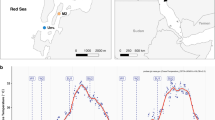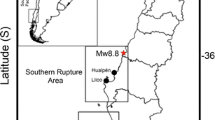Abstract
This study examined the latitudinal gradient of species diversity of rocky intertidal sessile assemblages on the slopes of rocks along the Northwestern Pacific coast of Japan, located between 31°N and 43°N, by explicitly incorporating an hierarchical spatial scale into the monitoring design. The specific questions were to examine: (1) whether there is a latitudinal gradient of regional diversity, (2) how spatial components of the regional diversity (local diversity and turnover diversity) vary with latitude depending on spatial scale, and (3) whether the latitudinal gradient differs between different measures of species diversity, i.e. species richness and Simpson’s diversity index. We measured coverage and the presence or absence of all sessile organisms in a total of 150 census plots established at five shores in each of six regions. The results showed that there were clear latitudinal gradients in regional species richness and in species turnover among shores. However, these patterns were not reflected in smaller-scale local species richness. For Simpson’s diversity index, there was no evidence of latitudinal clines either in regional diversity or in spatial components. These results suggest that relative abundance of common species does not vary along latitude, while the number of rare species increases with decreasing latitude.






Similar content being viewed by others
References
Asakura A (2003) Biogeography. In: Wada K (ed) Ecology of marine benthos. Tokai University Press, Hatano, pp 303–367
Astorga A, Fernández M, Boschi EE, Lagos N (2003) Two oceans, two taxa and one mode of development: latitudinal diversity patterns of South American crabs and test for possible causal processes. Ecol Lett 6:420–427
Briggs JC (1995) Global biogeography. Elsevier, Amsterdam
Buzas MA, Culver AJ (1989) Biogeographic and evolutionary patterns of continental margin benthic foraminifera. Palaeobiology 15:11–19
Buzas MA, Culver AJ (1991) Species diversity and dispersal of benthic foraminifera. Bioscience 41:483–489
Buzas MA, Culver AJ (1999) Understanding regional species diversity through the log series distribution of occurrences. Divers Distrib 8:187–195
Chown SL, Gaston KJ (2000) Areas, cradles and museums: the latitudinal gradient in species richness. Trends Ecol Evol 15:311–315
Clarke A, Lidgard S (2000) Spatial patterns of diversity in the sea: bryozoan species richness in the North Atlantic. J Anim Ecol 69:799–814
Currie DJ (1991) Energy and large-scale patterns of animal- and plant-species richness. Am Nat 137:27–49
Currie DJ, Paquin V (1987) Large-scale biogeographical patterns of species richness of trees. Nature 329:326–327
Dixon PM (2001) The bootstrap and the jacknife: describing the precision of ecological indices. In: Scheiner SM, Gurvitch J (eds) Design and analysis of ecological experiments. Oxford University Press, Oxford, pp 267–288
Ellingsen K, Gray JS (2002) Spatial patterns of benthic diversity: is there a latitudinal gradient along the Norwegian continental shelf? J Anim Ecol 71:373–389
Gaston KJ, Blackburn TM (2000) Pattern and process in macroecology. Blackwell, Oxford
Gering JC, Crist TO (2002) The alpha-beta-regional relationship: providing new insights into local-regional patterns of species richness scale dependence of diversity components. Ecol Lett 5:433–444
Gering JC, Crist TO, Veech JA (2003) Additive partitioning of species diversity across multiple spatial scales: implications for regional conservation of biodiversity. Conserv Biol 17:488–499
Gibbons DW, Reid JB, Chapman RA (1993) The new atlas of breeding birds in Britain and Ireland: 1988–1991. Poyser, London
Hedeker D, Gibbons RD (1996) MIXREG: a computer program for mixed-effects regression analysis with autocorrelated errors. Comp Meth Prog Biomed 49:229–252
Hori M, Noda T (2001) Spatio-temporal variation of avian foraging in the rocky intertidal food web. J Anim Ecol 70:122–137
Hubbell SP (1979) Tree dispersion, abundance, and diversity in a tropical dry forest. Science 203:1299–1309
Hubbell SP (2001) The unified neutral theory of biodiversity and biogeography. Princeton University Press, Princeton
Huston MA (1994) Biological diversity: the coexistence of species on changing landscapes. Cambridge University Press, Cambridge
Kaufman DM (1998) The structure of mammalian faunas in the New World: from continents to communities. Dissertation, University of New Mexico
Kawai H (1972) Hydrography of the Kuroshio extension. In: Stommel H, Yoshida K (eds) Kuroshio: its physical aspects. Tokyo University Press, Tokyo, pp 235–352
Kendall MA, Aschan M (1993) Latitudinal gradients in the structure of macrobenthic communities: a comparison of Arctic, temperate and tropical sites. J Exp Mar Biol Ecol 172:157–169
Koleff P, Lennon JJ, Gaston KJ (2003) Are there latitudinal gradient in species turnover? Glob Ecol Biogeogr 12:483–498
Krebs CJ (2001) Ecology. 5th edn. Benjamin Cummings, San Francisco
Lande R (1996) Statistic and partitioning of species diversity, and similarity among multiple communities. Oikos 76:5–13
Lawton JH (1976) The structure of the arthropod community on bracken. Bot J Linn Soc 73:187–216
Lewinsohn TM (1991) Insects in flower heads of Asteraceae in Southeast Brazil: a case study on tropical species richness. In: Price PW, Lewinsohn TM, Fernandes GW, Benson WW (eds) Plant-animal interactions: evolutionary ecology in tropical and temperate regions. Wiley, New York, pp 525–559
Lidgard S (1990) Growth in encrusting cheilostone bryozoan. II. Circum-Atlantic distribution pattern. Palaeobiology 16:304–321
Loreau M (2000) Are communities saturated? On the relationship between α, β and γ diversity. Ecol Lett 3:73–76
McGowan JA, Walker PW (1993) Pelagic diversity patterns. In: Ricklefs RE, Schluter D (eds) Species diversity in ecological communities: historical and geographical perspectives. University of Chicago Press, Chicago, pp 203–214
Miyamoto Y, Noda T (2004) Mussel effects on competitive inferior species varying from competitive exclusion to facilitation. Mar Ecol Prog Ser (in press)
Mokievsky V, Azovsky A (2002) Re-evaluation of species diversity patterns of free-living marine nematodes. Mar Ecol Prog Ser 238:101–108
Navarrete SA (1996) Variable predation: effects of whelks on a mid-intertidal successional community. Ecol Monogr 66:301–321
Nishimura S (1992) Guide to seashore animals of Japan with color pictures and keys, vol 2. Hoikusha, Osaka
Noda T (2004) Spatial hierarchal approach in community ecology: a way beyond a low predictability in local phenomenon. Popul Ecol (in press)
Noda T, Minamiura N, Miyamoto Y (2003) Seasonal changes in an intertidal annual algal assemblage in northern Japan: the role of pre-emption and grazing on algal replacement. Ecol Res 18:695–709
Paine RT (1966) Food web complexity and species diversity. Am Nat 100:65–75
Raudenbush SW, Bryk AS (2002) Hierarchical linear models: applications and data analysis methods, 2nd edn. Advanced quantitative techniques in the social sciences series 1. Sage, Thousand Oaks
Reid JL, Brinton E, Fleminger A, Venrick EL, McGowan JA (1978) Ocean circulation and marine life. In: Garnock H, Deacon G (eds) Advances in oceanography: Proceedings of the general symposium of the joint oceanographic assembly (13–24 September, 1976, Edinburgh). Plenum, New York, pp 66–130
Rex MA, Stuart CT, Hessler RR, Allen JA, Sanders HL, Wilson GDF (1993) Global-scale latitudinal patterns of species diversity in the deep-sea benthos. Nature 365:636–639
Rivadeneria MM, Fernández M, Navarrete SA (2002) Latitudinal trends of species diversity in rocky intertidal herbivore assemblages: spatial scale and the relationship between local and regional species richness. Mar Ecol Prog Ser 245:123–131
Rohde K (1992) Latitudinal gradients in species diversity: the search for the primary cause. Oikos 65:514–527
Rosenzweig ML (1995) Species diversity in space and time. Cambridge University Press, Cambridge
Roughgarden J (1986) A comparison of food-limited and space limited animal competition communities. In: Diamond J, Case TJ (eds) Community ecology. Harper and Row, New York, pp 492–516
Roy K, Jablonsky DJ, Valentine JW, Rosenberg G (1998) Marine latitudinal diversity gradients: tests of causal hypotheses. Proc Natl Acad Sci USA 95:3699–3702
Scheiner SM, Cox SB, Willing M, Mittlebach GG, Osenberg C, Kaspari M (2000) Species richness, species-area curves and Simpson’s paradox. Evol Ecol Res 2:791–802
Stehli FG (1968) Taxonomic diversity gradients in pole location: recent model. In: Drake ET (eds) Evolution and environment. Yale University Press, New Haven, pp 163–227
Stehli FG, McAlester AL, Helsley CE (1967) Taxonomic diversity of recent bivalves and some implications for geology. Geol Soc Am Bull 78:455–466
Stehli FG, Douglas RG, Newell ND (1969) Generation and maintenance of gradients in taxonomic diversity. Science 164:947–949
Stevens RD, Willing MR (2002) Geographical ecology at the community level: perspectives of the diversity of New World bats. Ecology 83:545–560
Sugimoto T (1990) A review of recent physical investigations on the straits around the Japanese islands. In: Pratt L (eds) The physical oceanography of sea straits. Kluwer, Dordrecht, pp 191–209
Systat (2002) SYSTAT version 10.2. Systat, Richmond
Tokeshi M (1999) Species coexistence. Blackwell, London
Turner JRG, Lennon JJ, Greenwood JJD (1996) Does climate cause the global biodiversity gradient? In: Hochberg ME, Clobert J, Barbault R (eds) Aspects of the genesis and maintenance of biological diversity. Oxford University Press, Oxford, pp 199–220
Acknowledgements
This work was made possible by the generous support and encouragement of local fishermen and the fishery officers of the Fisherman’s Cooperative Associations in Hokkaido, Iwate, Chiba, Wakayama, and Kagoshima Prefectures. We are grateful to staff and students at Akkeshi Marine Station of Hokkaido University, International Coastal Research Center of Ocean Research Institute, The University of Tokyo, Marine Biosystems Research Center of Chiba University, Seto Marine Biological Laboratory of Kyoto University, and the Education and Research Center for Marine Environment and Resources of Kagoshima University for field and laboratory facilities. We thank S. Hashizume, T. Yamanoi, M. Takahata, N. Kouchi, Y. Ishikawa, T. Tatematsu, S. Ninomiya, and R. Shimamura for their help in the fieldwork, H. Yasui, T. Hasegawa, T. Sasaki, M. Takahata, N. Kouchi for taxonomic identifications of intertidal organisms, and M. Hori for discussions and comments. This research was supported by grants-in-aid from the Ministry of Education, Culture, Sports, Science and Technology, Japan (No. 14340242).
Author information
Authors and Affiliations
Corresponding author
Additional information
An erratum to this article can be found at http://dx.doi.org/10.1007/s10144-004-0190-z
Rights and permissions
About this article
Cite this article
Okuda, T., Noda, T., Yamamoto, T. et al. Latitudinal gradient of species diversity: multi-scale variability in rocky intertidal sessile assemblages along the Northwestern Pacific coast. Popul Ecol 46, 159–170 (2004). https://doi.org/10.1007/s10144-004-0185-9
Received:
Accepted:
Published:
Issue Date:
DOI: https://doi.org/10.1007/s10144-004-0185-9




